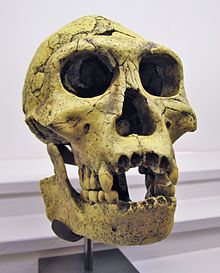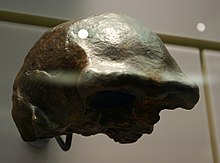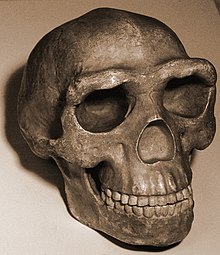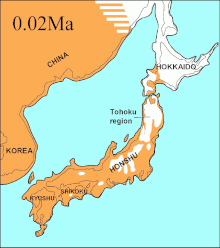User:Abyssal/Prehistory of Asia
Appearance
Introduction
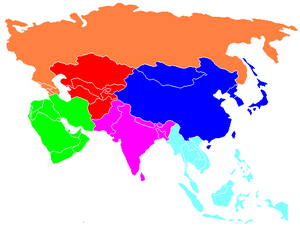
North Asia
Central Asia
East Asia
West Asia
South Asia
Southeast Asia
Prehistoric Asia refers to events in Asia during the period of human existence prior to the invention of writing systems or the documentation of recorded history. This includes portions of the Eurasian land mass currently or traditionally considered as the continent of Asia. The continent is commonly described as the region east of the Ural Mountains, the Caucasus Mountains, the Caspian Sea, Black Sea and Red Sea, bounded by the Pacific, Indian, and Arctic Oceans. This article gives an overview of the many regions of Asia during prehistoric times. (Full article...)
Selected general articles
-
The Bactria–Margiana Archaeological Complex (BMAC) is the modern archaeological designation for a particular Middle Bronze Age civilisation of southern Central Asia, also known as the Oxus Civilization. The civilisation's urban phase or Integration Era, was dated in 2010 by Sandro Salvatori to c. 2400–1950 BC, but a different view is held by Nadezhda A. Dubova and Bertille Lyonnet, c. 2250–1700 BC.
Though it may be called the "Oxus civilization", apparently centred on the upper Amu Darya (Oxus River) in Bactria, most of the BMAC's urban sites are actually located in Margiana (modern Turkmenistan) on the Murghab river delta, and in the Kopet Dagh mountain range. There are a few later (c. 1950–1450 BC) sites in northern Bactria, currently known as southern Uzbekistan, but they are mostly graveyards belonging to the BMAC-related Sapalli culture. A single BMAC site, known as Dashli, lies in southern Bactria, current territory of northern Afghanistan. Sites found further east, in southwestern Tajikistan, though contemporary with the main BMAC sites in Margiana, are only graveyards, with no urban developments associated with them. (Full article...) -
The Bronze Age in the Indian subcontinent begins around 3000 BCE, and in the end gives rise to the Indus Valley Civilisation, which had its (mature) period between 2600 BCE and 1900 BCE. It continues into the Rigvedic period, the early part of the Vedic period. It is succeeded by the Iron Age in India, beginning in around 1000 BCE.
South India, by contrast, remains in the Mesolithic stage until about 2500 BCE. (Full article...) -
Replica of Dmanisi Skull 3, the skull of an adolescent individual, discovered in 2001
The Dmanisi hominins,' Dmanisi people, or Dmanisi man were a population of Early Pleistocene hominins whose fossils have been recovered at Dmanisi, Georgia. The fossils and stone tools recovered at Dmanisi range in age from 1.85 to 1.77 million years old,' making the Dmanisi hominins the earliest well-dated hominin fossils in Eurasia and the best preserved fossils of early Homo from a single site so early in time, though earlier fossils and artifacts have been found in Asia. Though their precise classification is controversial and disputed, the Dmanisi fossils are highly significant within research on early hominin migrations out of Africa. The Dmanisi hominins are known from over a hundred postcranial fossils and five famous well-preserved skulls, referred to as Dmanisi Skulls 1–5.
The taxonomic status of the Dmanisi hominins is somewhat unclear due to their small brain size, primitive skeletal architecture, and the range of variation exhibited between the skulls. Their initial description classified them as Homo (erectus?) ergaster (an otherwise African taxon), or potentially an early offshoot of later Asian H. erectus. The discovery of a massive jaw, D2600, in 2000 led researchers to hypothesize that more than one hominin taxon had been present at the site and in 2002, the jaw was designated as the type specimen of the new species Homo georgicus. Later analyses by the Dmanisi research team have concluded that all the skulls likely represent the same taxon with significant age-related and sexual dimorphism, though this is not a universally held view. In 2006, the team favoured subsuming the taxon under Homo erectus as H. erectus georgicus or H. e. ergaster georgicus. The nomenclature is still debated. (Full article...) -
'Ubeidiya (Arabic: العبيدية, romanized: `Ubaydiyya; Hebrew: עובידיה), some 3 km south of the Sea of Galilee, in the Jordan Rift Valley, Israel, is an archaeological site of the early Pleistocene, c. 1.5 million years ago, preserving traces of one of the earliest migrations of Homo erectus out of Africa, with (as of 2014) only the site of Dmanisi in Georgia being older. The site yielded hand axes of the Acheulean type, but very few human remains. The animal remains include a hippopotamus' femur bone, and an immensely large pair of horns belonging to a species of extinct bovid.
The site was discovered in 1959 and was first excavated between 1960 and 1974. (Full article...) -
The Caucasus region, on the gateway between Southwest Asia, Europe and Central Asia, plays a pivotal role in the peopling of Eurasia,
possibly as early as during the Homo erectus expansion to Eurasia,
in the Upper Paleolithic peopling of Europe,
and again in the re-peopling Mesolithic Europe following the Last Glacial Maximum, and in the expansion associated with the Neolithic Revolution. (Full article...) -
The names for archaeological periods vary enormously from region to region. This is a list of the main divisions by continent and region. Dating also varies considerably and those given are broad approximations across wide areas.
The three-age system has been used in many areas, referring to the prehistorical and historical periods identified by tool manufacture and use, of Stone Age, Bronze Age and Iron Age. Since these ages are distinguished by the development of technology, it is natural that the dates to which these refer vary in different parts of the world. In many regions, the term Stone Age is no longer used, as it has been replaced by more specific geological periods. For some regions, there is need for an intermediate Chalcolithic period between the Stone Age and Bronze Age. For cultures where indigenous metal tools were in less widespread use, other classifications, such as the lithic stage, archaic stage and formative stage refer to the development of other types of technology and social organization. (Full article...) -
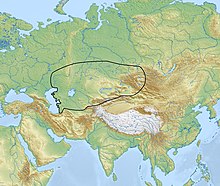
The Andronovo culture is a collection of similar local Late Bronze Age cultures that flourished c. 2000–1150 BC, spanning from the southern Urals to the upper Yenisei River in central Siberia. Some researchers have preferred to term it an archaeological complex or archaeological horizon. The slightly older Sintashta culture (c. 2200–1900 BC), formerly included within the Andronovo culture, is now considered separately to Early Andronovo cultures. Andronovo culture's first stage could have begun at the end of the 3rd millennium BC, with cattle grazing, as natural fodder was by no means difficult to find in the pastures close to dwellings.
Most researchers associate the Andronovo horizon with early Indo-Iranian languages, though it may have overlapped the early Uralic-speaking area at its northern fringe and Yeniseian-speaking area to its eastern fringe. Allentoft et al. (2015) concluded from their genetic studies that the Andronovo culture and the preceding Sintashta culture should be partially derived from the Corded Ware culture, given the higher proportion of ancestry matching the earlier farmers of Europe, similar to the admixture found in the genomes of the Corded Ware population. (Full article...) -
The prehistory of Anatolia stretches from the Paleolithic era through to the appearance of classical civilisation in the middle of the 1st millennium BC. It is generally regarded as being divided into three ages reflecting the dominant materials used for the making of domestic implements and weapons: Stone Age, Bronze Age and Iron Age. The term Copper Age (Chalcolithic) is used to denote the period straddling the stone and Bronze Ages.
Anatolia (Turkish: Anadolu), also known by the Latin name of Asia Minor, is considered to be the westernmost extent of Western Asia. Geographically it encompasses the central uplands of modern Turkey, from the coastal plain of the Aegean Sea east to the western edge of the Armenian Highlands and from the narrow coast of the Black Sea south to the Taurus mountains and Mediterranean Sea coast. (Full article...) -
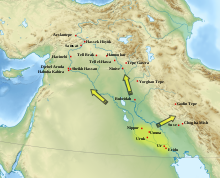
The Uruk period (c. 4000 to 3100 BC; also known as Protoliterate period) existed from the protohistoric Chalcolithic to Early Bronze Age period in the history of Mesopotamia, after the Ubaid period and before the Jemdet Nasr period. Named after the Sumerian city of Uruk, this period saw the emergence of urban life in Mesopotamia and the Sumerian civilization. The late Uruk period (34th to 32nd centuries) saw the gradual emergence of the cuneiform script and corresponds to the Early Bronze Age; it has also been described as the "Protoliterate period".
It was during this period that pottery painting declined as copper started to become popular, along with cylinder seals. (Full article...) -
The Levant is the area in Southwest Asia, south of the Taurus Mountains, bounded by the Mediterranean Sea in the west, the Arabian Desert in the south, and Mesopotamia in the east. It stretches roughly 400 mi (640 km) north to south, from the Taurus Mountains to the Sinai desert and Hejaz, and east to west between the Mediterranean Sea and the Khabur river. The term is often used to refer to the following regions or modern states: the Hatay Province of Turkey, Syria, Lebanon, Israel, Palestine, and Jordan. The term sometimes include Cilicia, Cyprus and the Sinai Peninsula.
The Levant is one of the earliest centers of sedentism and agriculture throughout history, and some of the earliest agrarian cultures, Pre-Pottery Neolithic, developed in the region. Previously regarded as a peripheral region in the ancient Near East, modern academia largely considers the Levant as a center of civilization on its own, independent of Mesopotamia and Egypt. Throughout the Bronze and Iron ages, the Levant was home to many ancient Semitic-speaking peoples and kingdoms, and is considered by many to be the urheimat of Semitic languages. (Full article...) -
Zarzian culture is an archaeological culture of late Paleolithic and Mesolithic in Southwest Asia.
The period of the culture is estimated to have existed about 18,000–8,000 BCE. It was preceded by the Baradostian culture in the same region and was related to the Imeretian culture of the Caucasus. (Full article...) -
This is a list of Paleolithic sites in China. They are sorted in chronological order from the earliest founding to the latest: (Full article...)
-
Daimabad is a deserted village and archaeological site on the left bank of the Pravara River, a tributary of the Godavari River in Shrirampur taluka in Ahmednagar district of Maharashtra state in India. This site was discovered by B. P. Bopardikar in 1958. It has been excavated three times so far by the Archaeological Survey of India teams. The first excavation in 1958-59 was carried out under the direction of M. N. Deshpande. The second excavation in 1974-75 was led by S. R. Rao. Finally, the excavations between 1975-76 and 1978-79 were carried out under the direction of S. A. Sali. Discoveries at Daimabad suggest that Late Harappan culture extended into the Deccan Plateau in India. Daimabad is famous for the recovery of many bronze goods, some of which were influenced by the Harappan culture. (Full article...)
-
Riwat (Rawat, Murree) is a Paleolithic site in Punjab, northern Pakistan. Another site, called Riwat Site 55, shows a later occupation dated to around 45,000 years ago. (Full article...)
-
Solo Man (Homo erectus soloensis) is a subspecies of H. erectus that lived along the Solo River in Java, Indonesia, about 117,000 to 108,000 years ago in the Late Pleistocene. This population is the last known record of the species. It is known from 14 skullcaps, two tibiae, and a piece of the pelvis excavated near the village of Ngandong, and possibly three skulls from Sambungmacan and a skull from Ngawi depending on classification. The Ngandong site was first excavated from 1931 to 1933 under the direction of Willem Frederik Florus Oppenoorth, Carel ter Haar, and Gustav Heinrich Ralph von Koenigswald, but further study was set back by the Great Depression, World War II and the Indonesian War of Independence. In accordance with historical race concepts, Indonesian H. erectus subspecies were originally classified as the direct ancestors of Aboriginal Australians, but Solo Man is now thought to have no living descendants because the remains far predate modern human immigration into the area, which began roughly 55,000 to 50,000 years ago.
The Solo Man skull is oval-shaped in top view, with heavy brows, inflated cheekbones, and a prominent bar of bone wrapping around the back. The brain volume was quite large, ranging from 1,013 to 1,251 cubic centimetres (61.8 to 76.3 cu in), compared to an average of 1,270 cm3 (78 cu in) for present-day modern males and 1,130 cm3 (69 cu in) for present-day modern females. One potentially female specimen may have been 158 cm (5 ft 2 in) tall and weighed 51 kg (112 lb); males were probably much bigger than females. Solo Man was in many ways similar to the Java Man (H. e. erectus) that had earlier inhabited Java, but was far less archaic. (Full article...) -

Pre Historic Sites of the Middle Krishna-Tungabhadra River Valley of South India are probably the efficient paleolithic cultural areas as per the evidence found over the valley.
The South Asian Stone Age covers the Palaeolithic, Mesolithic and Neolithic periods in the Indian subcontinent. Evidence for the most ancient Homo sapiens in South Asia has been found in the cave sites of Cudappah of India, Batadombalena and Belilena in Sri Lanka. In Mehrgarh, in western Pakistan, the Neolithic began c. 7000 BCE and lasted until 3300 BCE and the Chalcolithic and early Bronze Age. In South India, the Mesolithic period lasted until 3000 BCE, and the Neolithic period until c. 1000 BCE, followed by a Megalithic transitional period, mostly skipping the Bronze Age. The Iron Age in India began roughly simultaneously in North and South India, around c. 1200 to 1000 BCE (Painted Grey Ware culture, Hallur, Paiyampalli). (Full article...) -
Java Man (Homo erectus erectus, formerly also Anthropopithecus erectus or Pithecanthropus erectus) is an early human fossil discovered in 1891 and 1892 on the island of Java (Indonesia). Estimated to be between 700,000 and 1,490,000 years old, it was, at the time of its discovery, the oldest hominid fossil ever found, and it remains the type specimen for Homo erectus.
Led by Eugène Dubois, the excavation team uncovered a tooth, a skullcap, and a thighbone at Trinil on the banks of the Solo River in East Java. Arguing that the fossils represented the "missing link" between apes and humans, Dubois gave the species the scientific name Anthropopithecus erectus, then later renamed it Pithecanthropus erectus. The fossil aroused much controversy. Within a decade of the discovery almost eighty books or articles had been published on Dubois's finds. Despite Dubois's argument, few accepted that Java Man was a transitional form between apes and humans. Some dismissed the fossils as apes and others as modern humans, whereas many scientists considered Java Man as a primitive side branch of evolution not related to modern humans at all. In the 1930s Dubois made the claim that Pithecanthropus was built like a "giant gibbon", a much misinterpreted attempt by Dubois to prove that it was the "missing link". Eventually, similarities between Java Man and Sinanthropus pekinensis (Peking Man) led Ernst Mayr to rename both Homo erectus in 1950, placing them directly in the human evolutionary tree. (Full article...) -
The categorisation of the past into discrete, quantified named blocks of time is called periodization. This is a list of such named time periods as defined in various fields of study.
These can be divided broadly into prehistorical periods and historical periods (when written records began to be kept). (Full article...) -
Pre-Pottery Neolithic A (PPNA) denotes the first stage of the Pre-Pottery Neolithic, in early Levantine and Anatolian Neolithic culture, dating to c. 12,000 – c. 10,800 years ago, that is, 10,000–8800 BCE. Archaeological remains are located in the Levantine and Upper Mesopotamian region of the Fertile Crescent.
The time period is characterized by tiny circular mud-brick dwellings, the cultivation of crops, the hunting of wild game, and unique burial customs in which bodies were buried below the floors of dwellings. (Full article...) -
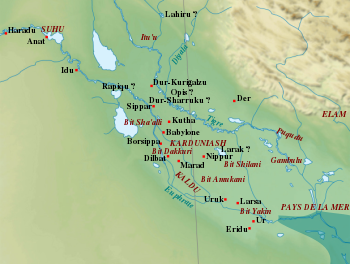
The Chaldean states in Babylonia during the 1st millennium BC.
Chaldea (/kælˈdiːə/) was a small country that existed between the late 10th or early 9th and mid-6th centuries BC, after which the country and its people were absorbed and assimilated into the indigenous population of Babylonia. Semitic-speaking, it was located in the marshy land of the far southeastern corner of Mesopotamia and briefly came to rule Babylon. The Hebrew Bible uses the term כשדים (Kaśdim) and this is translated as Chaldaeans in the Greek Old Testament, although there is some dispute as to whether Kasdim in fact means Chaldean or refers to the south Mesopotamian Kaldu.
During a period of weakness in the East Semitic-speaking kingdom of Babylonia, new tribes of West Semitic-speaking migrants arrived in the region from the Levant between the 11th and 9th centuries BC. The earliest waves consisted of Suteans and Arameans, followed a century or so later by the Kaldu, a group who became known later as the Chaldeans or the Chaldees. These migrations did not affect the powerful kingdom and empire of Assyria in Upper Mesopotamia, which repelled these incursions. (Full article...) -
This is a list of Neolithic cultures of China that have been unearthed by archaeologists. They are sorted in chronological order from earliest to latest and are followed by a schematic visualization of these cultures.
It would seem that the definition of Neolithic in China is undergoing changes. The discovery in 2012 of pottery about 20,000 years BC indicates that this measure alone can no longer be used to define the period. It will fall to the more difficult task of determining when cereal domestication started. (Full article...) -
Xiaochangliang (simplified Chinese: 小长梁; traditional Chinese: 小長梁; pinyin: Xiǎochángliáng) is the site of some of the earliest paleolithic remains in East Asia, located in the Nihewan (泥河灣) Basin in Yangyuan County, Hebei, China, most famous for the stone tools discovered there. (Full article...)
-
Peking Man (Homo erectus pekinensis) is a subspecies of H. erectus which inhabited the Zhoukoudian cave site in modern northern China during the Chibanian. The first fossil, a tooth, was discovered in 1921, and the Zhoukoudian Cave has since then become the most productive H. erectus site in the world. Peking Man was instrumental in the foundation of Chinese anthropology, and fostered an important dialogue between Western and Eastern science for decades to come. The fossils became the centre of anthropological discussion, and were classified as a direct human ancestor, propping up the Out of Asia hypothesis that humans evolved in Asia.
Peking Man also played a vital role in the restructuring of the Chinese identity following the Chinese Communist Revolution, and was intensively communicated to working class and peasant communities to introduce them to Marxism and science. Early models of Peking Man society strongly leaned towards communist or nationalist ideals, leading to discussions on primitive communism and polygenism. This produced a strong schism between Western and Eastern interpretations, especially as the West adopted the Out of Africa hypothesis by late 1967, and Peking Man's role in human evolution diminished as merely an offshoot of the human line. Though Out of Africa is now the consensus, Peking Man interbreeding with human ancestors is frequently discussed especially in Chinese circles. (Full article...) -
The Japanese Paleolithic period (旧石器時代, kyūsekki jidai) is the period of human inhabitation in Japan predating the development of pottery, generally before 10,000 BC. The starting dates commonly given to this period are from around 40,000 BC, with recent authors suggesting that there is good evidence for habitation from c. 36,000 BC onwards. The period extended to the beginning of the Mesolithic Jōmon period, or around 14,000 BC.
The earliest human bones were discovered in the city of Hamamatsu in Shizuoka Prefecture, which were determined by radiocarbon dating to date to around 18,000–14,000 years ago. (Full article...)
Things you can do
Desired articles, sorted by how frequently linked to:
- Archaeology of Asia
- Archaeology of Japan
- Archaeology of Tajikistan
- Archaeology of Brunei
- Archaeology of Iraq
- Archaeology of Cambodia
- Archaeology of Jordan
- Archaeology of Kyrgyzstan
- Archaeology of Laos
- Archaeology of Bangladesh
- Archaeology of Kuwait
- Archaeology of Christmas Island
- Archaeology of Bhutan
- Archaeology of Egypt
- Archaeology of Georgia (country)
- Archaeology of South Korea
- Archaeology of East Timor
- Archaeology of Hong Kong
- Archaeology of Sri Lanka
- Archaeology of Iran
- Archaeology of South Ossetia
- Archaeology of Saudi Arabia
- Archaeology of Macau
- Archaeology of Kazakhstan
- Archaeology of Taiwan
- Archaeology of the Palestinian territories
- Archaeology of the Republic of Artsakh
- Archaeology of Abkhazia
- Archaeology of the Maldives
- Archaeology of the Cocos (Keeling) Islands
- Archaeology of Turkmenistan
- Archaeology of Turkey
- Archaeology of Thailand
- Archaeology of Uzbekistan
- Archaeology of Vietnam
- Archaeology of the British Indian Ocean Territory
- Archaeology of Yemen
- Archaeology of Bahrain
- Archaeology of Nepal
- Archaeology of Syria
- Archaeology of Mongolia
- Archaeology of Malaysia
- Archaeology of Myanmar
- Archaeology of North Korea
- Budana
- John David Hawkins
- Gyanpura
- Kheri Lochab
- Khera Gandawala
- Rajpura, Narnaund
- Kagsar
- Nara, Hisar
- Sulchani
- Kinnar, Hisar
- Panihari village
- Gamra
- Pali, Narnaund
- Ukhaa Tolgod
- Geology of Asia
- Kurile arc
- Xinminpu Group
- Zhou Shiwu
- You Hailu
- Wang Xiaolin
- Paul Upchurch
- Shandong Tianyu Museum of Nature
- Cyclopygoidea
- Diapophysis
- Changma Basin
- Ukhaa Tolgod
- Kenilworth Sandstone Formation
- He Xinlu
- Cyclopygoidea
Selected images
-
Illustration of what Peking Man may have looked like. (from Prehistoric Asia)
-
The Ancient Paleo-Siberians formed from the Ancient North Eurasians and Ancient Northern East Asian ancestry, and are closely connected to the first wave of humans into the Americas. (from Prehistoric Asia)
-
Dolmen from Godavari district, Andhra Pradesh, India. Woodcut from the article "Indiska fornsaker" by Hans Hildebrand. (from Prehistoric Asia)
-
This skull of Homo erectus georgicus from Dmanisi in modern Georgia (Caucasus) is the earliest evidence for the presence of early humans outside the African continent. (from Prehistoric Asia)
-
Modern humans interbred with an archaic human species called Denisovans on the islands of Southeast Asia. (from Prehistoric Asia)
-
Early Indo-European migrations from the Pontic steppes and across Central Asia, and encounter with Ancient Northeast Asian populations. (from Prehistoric Asia)
-
Map of AsiaNorth AsiaCentral AsiaEast AsiaWest AsiaSouth AsiaSoutheast Asia(from Prehistoric Asia)
-
Model of a Yangshao culture village (4800–2500 BC) (from Prehistoric Asia)
Subcategories
Subtopics
Related portals
Associated Wikimedia
The following Wikimedia Foundation sister projects provide more on this subject:
-
Commons
Free media repository -
Wikibooks
Free textbooks and manuals -
Wikidata
Free knowledge base -
Wikinews
Free-content news -
Wikiquote
Collection of quotations -
Wikisource
Free-content library -
Wikiversity
Free learning tools -
Wiktionary
Dictionary and thesaurus



